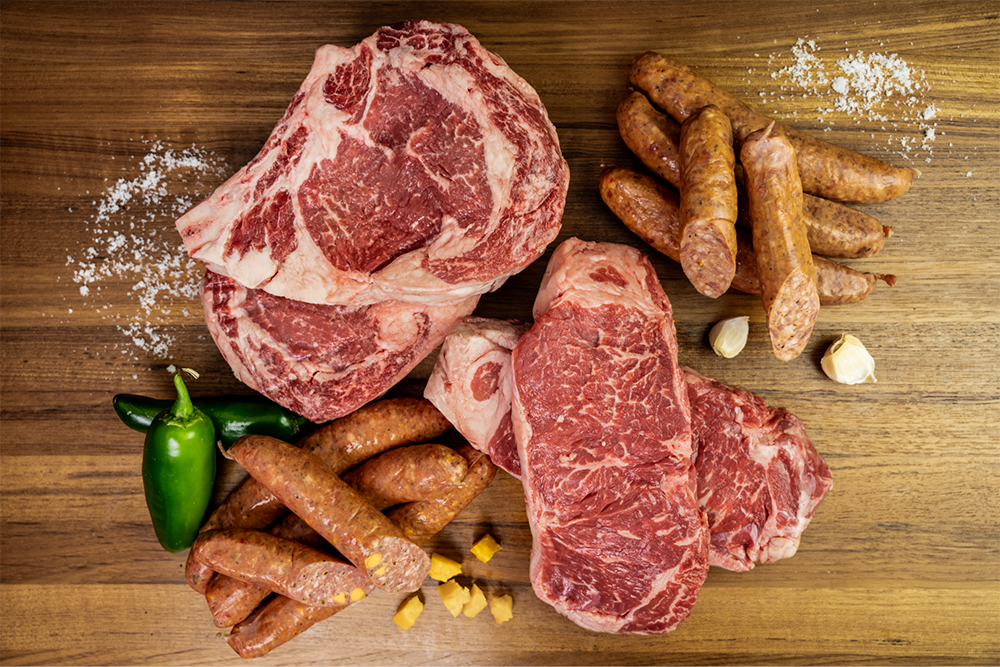What Makes Bagley Farms Meat Market Edwardsville IL Stand Out for Meat Lovers
What Makes Bagley Farms Meat Market Edwardsville IL Stand Out for Meat Lovers
Blog Article
Uncover the Art of the Butcher's Cut in a Modern Meat Market
In the ever-evolving landscape of contemporary meat markets, the butcher's cut has transcended its conventional roots, combining old-time workmanship with contemporary practices. Today's butchers are not merely cpus of meat; they are knowledgeable craftsmens that highlight sustainability and ethical sourcing. Their competence in choose and preparing cuts customized to certain culinary needs supplies an unparalleled eating experience. Yet, what absolutely establishes the modern butcher apart is their capacity to create a deeper link between consumers and the beginnings of their meat. How do these masters equilibrium custom with development, and what implications does this have for the future of meat usage?
Advancement of Butchery Methods
The advancement of butchery techniques mirrors a rich tapestry of advancement and adjustment driven by improvements in technology, modifications in consumer demand, and a much deeper understanding of meat scientific research. Historically, butchery was a craft passed down via generations, with techniques developed over centuries to maximize yield and taste. The industrial transformation ushered in automation, changing conventional methods and making it possible for large-scale processing.
The mid-20th century saw butchery methods better refined by scientific insights right into muscular tissue biology and meat aging, boosting both tenderness and taste. Developments like vacuum cleaner product packaging and refrigeration expanded item shelf-life, allowing butchers to diversify offerings and enhance high quality control. This duration additionally noted the surge of customized equipment, such as band saws and meat slicers, which increased precision and efficiency in meat processing.

Computerized systems now assist in monitoring pet provenance and enhancing cuts to satisfy specific consumer choices. Additionally, a resurgence in artisanal butchery has actually emerged, mixing standard skills with modern-day understanding to cater to customers seeking moral and lasting meat alternatives.
Comprehending Meat Cuts
Recognizing the details of meat cuts is vital for both butchers and customers seeking top quality and value. For butchers, exact cuts mirror skill and respect for the craft, making certain minimal waste and ideal return.

Comprehending muscle composition is critical; muscle mass utilized more regularly by the animal tend to be harder and are best suited for slow-moving cooking methods, while less-used muscular tissues, like those found in the loin, are more tender and suitable for grilling or roasting. Knowledge with these distinctions encourages consumers to make enlightened options, enhancing their cooking endeavors.
Choosing Quality Meat
Choosing the ideal meat entails more than just picking an aesthetically enticing item from the display. The art of choosing high quality meat calls for a discerning eye and knowledge of particular qualities that indicate freshness and excellence.
Secondly, think about the marbling, which refers to the white streaks of fat within the muscular tissue. Correct marbling is a vital indicator of inflammation and taste, as it melts throughout food preparation, boosting the meat's juiciness. Keep in mind, higher marbling typically correlates with superior quality cuts, such as USDA Prime.
Appearance is an additional critical element; meat ought to feel firm to the touch, not slimy or overly soft. Additionally, bear in mind the scent. Fresh meat ought to have a clean, neutral smell, without any sour or off-putting odors.
Coupling Cuts With Food Preparation Approaches

On the other hand, harder cuts like brisket and chuck roast are rich in collagen, other which damages down into gelatin when cooked slowly. These cuts are excellent for braising or slow roasting, allowing the meat to tenderize gradually and create deep, complex flavors. Cuts such as short ribs and pork shoulder moved here get on well with slow-cooking techniques, where prolonged cooking times change their durable appearances right into delicious recipes.
Lamb shanks and oxtail, which call for prolonged cooking to tenderize, are perfect candidates for cooking or slow-moving simmering. These approaches coax out abundant, passionate tastes while keeping dampness. By recognizing the one-of-a-kind features of each cut, cooks and home chefs alike can raise their culinary creations, making sure each meal is both satisfying and remarkable.
The Butcher's Duty Today
Browsing the developing landscape of the modern meat market, the butcher's function today extends past simple preparation of cuts. Contemporary butchers are cooking artisans, instructors, and supporters for sustainable techniques. They link the space in between the ranch and the fork by making sure ethical sourcing, recognizing more info here animal husbandry, and focusing on transparency in the supply chain. This change shows the expanding consumer need for high quality over amount, where provenance and animal well-being are vital.
In addition to crafting exact cuts, butchers now engage straight with customers, using cooking suggestions and tailoring choices to suit private demands and preferences. Their experience in meat aging, marbling, and flavor accounts empowers consumers to make educated choices, enhancing their culinary experiences. This tailored service exemplifies the butcher's advancing role as a trusted expert in the kitchen area.
In addition, butchers are critical in decreasing waste, utilizing whole pets to develop diverse products such as sausages and stocks. This detailed approach not only appreciates the pet yet also lines up with modern sustainability goals. In this method, the modern-day butcher embodies both custom and technology, adapting to an ever-changing market while protecting the virtuosity and integrity of their craft.
Conclusion
The modern butcher's craft delicately weaves typical methods with contemporary advancements, stressing lasting practices and honest sourcing. Proficiency in understanding varied meat cuts and quality indicators empowers butchers to offer informed recommendations, aligning specific cuts with optimal cooking methods. This knowledge not only elevates cooking experiences yet likewise enhances the connection between consumers and the origins of their food. By recognizing historic techniques while welcoming contemporary demands, the butcher's function continues to be crucial in today's advanced meat market (bagley farms meat market edwardsville il).
Report this page